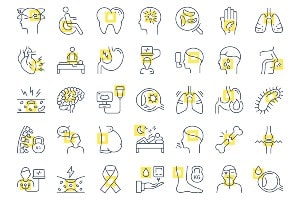About Lymphocytic Colitis

Learn about the disease, illness and/or condition Lymphocytic Colitis including: symptoms, causes, treatments, contraindications and conditions at ClusterMed.info.
Lymphocytic Colitis

| Lymphocytic Colitis |
|---|
Lymphocytic Colitis InformationCan microscopic colitis be prevented?Since the cause of microscopic colitis is not known, no advice can be provided about preventing this disease. How common is microscopic colitis and who is at risk?The prevalence of microscopic colitis in the U.S. is not clearly known.Microscopic colitis most commonly occurs in the middle aged and elderly patients and is more common among women than men. How is microscopic colitis diagnosed?The diagnosis of microscopic colitis is made by performing biopsies from different regions of the colon during colonoscopy or sigmoidoscopy.The abnormalities of the colon's lining in microscopic colitis occur in a patchy distribution (areas of normal lining may coexist adjacent to areas of abnormal lining). For this reason, multiple biopsies should be taken from several different regions of the colon in order to accurately make a diagnosis.The patchy nature of microscopic colitis also is the reason why flexible sigmoidoscopy often is inadequate in diagnosing the condition because the abnormalities of microscopic colitis may be absent from the sigmoid colon (the colonic segment that is closest to the rectum and is within the reach of a sigmoidoscope) in some of the patients with microscopic colitis.Thus, biopsies of other regions of the colon accessible only with colonoscopy may be necessary for diagnosing microscopic colitis. What are the symptoms of microscopic colitis?The primary symptom of microscopic colitis is chronic, watery diarrhea. Individuals with microscopic colitis can have diarrhea for months or years before the diagnosis is made. Typically, the symptoms begin very gradually and are intermittent in nature with periods when the person feels well, followed by bouts of chronic diarrhea. This chronic diarrhea of microscopic colitis is different from the acute diarrhea of infectious colitis, which typically lasts only days to weeks. Some individuals with microscopic colitis also may experience mild abdominal cramps and pain. Blood in the stool is unusual. What causes microscopic colitis?The cause(s) of microscopic colitis is unknown. Some experts suspect that microscopic colitis is an autoimmune disorder similar to the autoimmune disorders that cause chronic ulcerative colitis and Crohn's disease. One study has implicated long term (longer than 6 months) use of nonsteroidal anti-inflammatory drugs (NSAIDs) as a cause of microscopic colitis. Some individuals' diarrhea improves after stopping the NSAIDs. Several other drugs have also been incriminated as a cause of microscopic colitis. The most common are proton pump inhibitors (PPIs) such as lansoprazole (Prevacid, Prevacid SoluTab), omeprazole (Prilosec, Zegerid), and esomeprazole (Nexium); the Statin simvastatin (Zocor); H2 blocker ranitidine (Zantac); SSRI sertraline Zoloft); and P2Y12 inhibitor ticlopidine (Tilcid). What diseases are not colitis?Individuals with irritable bowel syndrome (IBS) do not have colitis, even though this condition is sometimes referred to as having "spastic colitis." These individuals may have symptoms that mimic colitis such as diarrhea, abdominal pain, and mucus in stool. Nevertheless, there is no inflammation of the colon in patients with IBS. The cause of symptoms in IBS is not clearly known; it may be caused by either abnormal motility (abnormal contractions) of the intestinal muscles or abnormally sensitive nerves in the intestines (visceral hypersensitivity). What is colitis?Colitis means inflammation of the colon. The colon, also known as the large intestine or large bowel, constitutes the last part of the digestive tract. The colon is a long, muscular tube that receives digested food from the small intestine. It removes water from the undigested food, stores the undigested food, and then eliminates it from the body through bowel movements. The rectum is the last part of the colon adjacent to the anus. The common symptoms of colitis include:
What is microscopic colitis?Microscopic colitis refers to inflammation of the colon that is only visible when the colon's lining is examined under a microscope. The appearance of the inner colon lining in microscopic colitis is normal by visual inspection during colonoscopy or flexible sigmoidoscopy. The diagnosis of microscopic colitis is made when a doctor, while performing colonoscopy or flexible sigmoidoscopy, takes biopsies (small samples of tissue) of the normal-appearing lining, and then examines the biopsies under a microscope. There are two types of microscopic colitis: 1) lymphocytic colitis and 2) collagenous colitis.
What is the prognosis of microscopic colitis?The long term prognosis (course) of microscopic colitis is not clear. In approximately two-thirds of the patients with microscopic colitis, the diarrhea resolves spontaneously after several years. The remaining one-third of the patients with microscopic colitis experience persistent or intermittent diarrhea and/or abdominal pain for many years (possibly indefinitely) as there is no cure for the condition. What is the treatment for microscopic colitis?The treatment of microscopic colitis has not been standardized because there have not been adequate large scale, prospective, placebo controlled treatment trials. The following strategies are safe and may relieve diarrhea in some patients:
When should I seek medical care for microscopic colitis?A person should seek medical care if the diarrhea lasts for more than 2 weeks or is accompanied with symptoms such as weight loss, fatigue, and abdominal pain. |
More Diseases
A | B | C | D | E | F | G | H | I | J | K | L | M | N | O | P | Q | R | S | T | U | V | W | X | Y | Z
Diseases & Illnesses Definitions Of The Day
- Eating, Emotional (Emotional Eating) ‐ Emotional eating facts, How do health care providers diagnose emotional eating? …
- OTC Drugs for Constipation (Laxatives For Constipation) ‐ Are laxatives safe to take during pregnancy or while breastfeeding? …
- Hyopgonadism, Primary (Low Testosterone (Low T)) ‐ How do you know if you have low testosterone (Low-T)?, Should I take testosterone? …
- Poisoning, Ciguatera (Ciguatera Poisoning) ‐ What are the symptoms of ciguatera poisoning?, What is ciguatera poisoning? …
- Head and Neck Cancer ‐ Head and neck cancer facts*, How are head and neck cancers diagnosed? …
- XXY Males (Klinefelter Syndrome) ‐ Klinefelter syndrome facts*, Language development, Physical development …
- Devic's Syndrome ‐ How is neuromyelitis optica diagnosed?, Neuromyelitis optica facts* …
- Myocarditis ‐ How is myocarditis diagnosed?, What are symptoms of myocarditis? …
- Cancer of the Testis (Testicular Cancer) ‐ After testicular cancer has been diagnosed, tests are done to find out if cancer cells have spread within the testicles or to other parts of the body. …
- Chronic Rhinitis ‐ Chronic rhinitis and post-nasal drip definition and facts, Does salt water or nasal irrigation have any role in the treatment of rhinitis and post-nasal drip? …